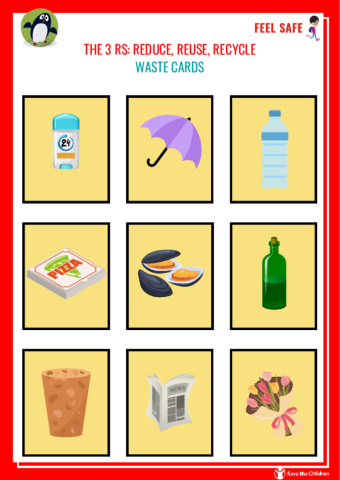The 3 Rs: Reduce, Reuse, Recycle
Objectives:
- Understand the concepts of reduce, reuse and recycle, and their impact on the environment.
- Promote environmentally friendly behaviors and share the knowledge gained with families and the community
Before starting
The teacher begins with a brief introduction on the importance of recycling and the circular economy. To actively engage students, the following stimulus questions can be used:
- What does 'waste sorting' mean to you? What do you do at home?
- What types of waste do you think we produce most in our daily lives?
- Have you ever tried to repair something instead of throwing it away? If yes, what and how have you done it?
After collecting responses, the teacher introduces the concept of circular economy as a sustainable model that aims to minimize waste and extend the life of products. The three basic principles of circular economy are presented:
- Reduce: consume fewer natural resources.
- Reuse: extend the useful life of objects.
- Recycle: properly dispose of waste to turn it into new resources.
The teacher can show the class the following video to explore the topic further:
Waste Relay
The teacher divides the class into 4 teams. They are presented with 5 colored containers (alternatively you can draw them on cardboard) for the different recycling categories (plastic, paper, glass, metal, organic) and are given cards, of different colors, representing the various wastes (see attachment “The 3 Rs: Reduce, Reuse, Recycle - Waste Cards” below) to each group.
At the teacher's go-ahead, each group will have 3 minutes to correctly place their cards in the correct containers, being sure to confront each other and reflect on the existing regulations in their local municipality.
At the 3-minute mark, the teacher will check the contents of each container and reflect with the class on the choices made and on the materials of the waste placed. The teacher will evaluate the teams and determine the winner based on the number of mistakes made.
At the end of the confrontation, each team will have to choose one of their Refuse Cards to face the “Jolly Test” which will allow them to overturn the outcome of the previous test where it is passed by another of the competing teams.
The test consists of reflecting on the chosen Card and, by being creative, proposing a “second life” for the object. The time limit for the test is 15 minutes in which the group can discuss together and decide how to transform the “Jolly Waste” paying special attention to the concepts of reuse and recycling.
Students will have to present their idea by briefly writing down how they plan to use the new object and make a quick drawing of their creation.
The winning team may be awarded a “ Sustainability Development that ensures that the needs of the present generation are met without compromising the ability of future generations to meet their own needs Prize”, such as a small plant to care for or seeds to plant in the school garden.
Concluding thoughts
The teacher initiates a time for final reflections by briefly summarizing the key concepts addressed through the game, such as the principles of reduce, reuse, and recycle. It is essential at this stage to emphasize how fundamental these principles are in the context of the circular economy and how they can positively affect our environment.
The following stimulus questions can be used to guide reflection:
- What materials or objects have you identified as most difficult to recycle or reuse? Why?
- What do you think you could suggest to your parents to improve recycling collection at home?

Add new comment